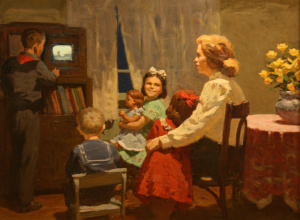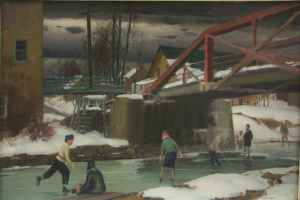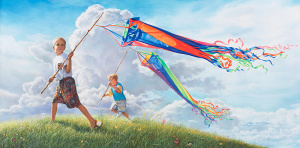Children in Art Postcard Set
This page provides additional information about the images included in the Children in Art postcard set.
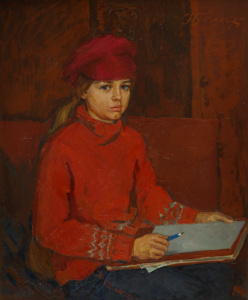
Nadezhda Aleksandrovna Belykh
(1935 - ) Pochinok, Kostroma, Russia
Luba Portrait of Artists’ Daughter 1975
oil on canvas
Nadezhda was born in 1935 in the Kostromskaya Province, north of Moscow. She studied in the Kostromsaya art institute, finishing in 1960. Belykh painted many scenes of maternity and childhood, but her favorite genre was still life. She also loved to paint scenes from nature,especially the fruits of labor of farmers and workers. Belykh's painting can be found in Russia, and abroad, including Finland, Japan, and Germany.
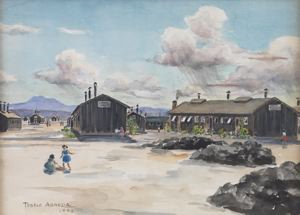
Toshio Asaeda
(1893-1968)
Tokyo, Japan Barracks 5 & 6, Block 28 Seen from East, Topaz 1943
watercolor, 10” x 14”
Toshio Asaeda was a Japanese-born artist who spent the majority of his career in California. He studied with Hans Hofman in the early 1930's at the University of California Berkeley. A gifted draftsman, Asaeda worked as a documentary illustrator of marine and wildlife and later as an artist and assistant curator at the California Institute of Technology in Pasadena. In 1942, Asaeda’s career was interrupted by the United States government’s forced relocation of Japanese Americans to internment camps throughout the western United States. Asaeda and his wife were sent to the internment camp at Topaz, Utah, in western Juab County. When the camp closed in 1945, the artist returned to California and continued his career as an artist and curator at California Institute of Technology. He passed away in San Francisco, California in 1968.
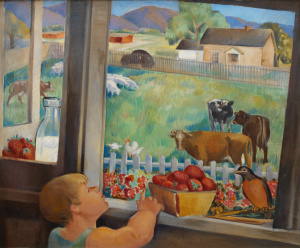
(Clara) Irene Thompson Fletcher
(1900-1969)
Cache Valley Innocence 1937
oil on canvas mounted, 29.88” x 36.38”
The Calvin Fletcher student group is an impressive one, a good example of this is the artistic accomplishment of a young Hooper, Utah widow who took classes from the Logan master in the mid-1920s. Her name was Clara Irene Thompson (b. Oct. 17), and she was Fletcher's charming "star" pupil in 1925-26. In fact, her "personality endeared her to everyone, especially to the teacher." Zettie Fletcher, the professor's second wife, had died giving birth to her sixth child, and with Sarah Ann Fletcher's two children that made eight, that is until December 24, 1926 when Calvin Fletcher and Irene Thompson were married, her six children bringing the total to 14! Irene Thompson Fletcher had also taken classes from Harry Reynolds and she would also study with Floyd Cornaby and (in summers) with Gaylen Hansen, B.J.O. Nordfelt, Otis Oldfield, Ralph Pearson, Lee Randolph, and Birger Sandzen. And like Calvin, from these teachers (and from her husband as well), she was to develop a thorough-going understanding of "modern" style and then an admirably controlled and often gracious sense of artistic interpretation beyond the initial appearance of things in nature.

Corinne Geertsen
(1953 - ) Great Falls, Montana
Grand Tour 2012
digital photo collage, 28” x 34”
Corinne Geertsen’s work often includes representations of spanning horizons, inspired by the scenery of her Montana childhood. Growing up with a fascination for her psychologist father’s picture plates, Geertsen frequently creates narrative works imbued with psychological twists.
While Geertsen’s work is created digitally, she utilizes photographs from the past in her creations. These photographs range from old family photos to portraits from the Civil War era, to photos she has personally taken during her various adventures.
Of her art, Geertsen has said: “It’s all about remix… My images are quirky visual narratives about psychological predicaments. I especially like a good plight. My art leans toward surrealism, as it has odd juxtapositions, non-sequiturs, and an element of surprise.”
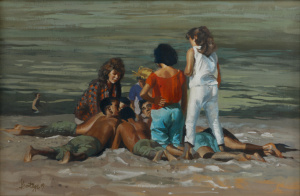
Harrison Thomas Groutage
(1925-2013) Richmond, Utah
Integration 1959
gouache/tempra, 24.25” x 36.75”
Harrison Groutage was born on April 21, 1925 in Richmond Utah. Groutage spent much of his life on the University level whether it was as a student or a teacher. He attended Utah State University and Weber State before he went on to Brigham Young University where he received his Bachelors Degree in 1953. He then studied at the University of Utah and received a Master’s of Fine Arts degree in 1954. Groutage later went back in 1963 and did Post Graduate work at Iowa State University.
Between 1952 and 1963 when Groutage did his Post Graduate work he spent a lot of time not only on his artwork and school but getting his feet wet with teaching. Groutage was often very popular with his students not only because of his artistic talents but also because of is facile mind and quick wit. He first taught at Snow College from 1952-53. Then Groutage obtained an art position at Utah State University, which he would keep for over 30 years. While he taught at Utah State he was also a guest instructor for summer sessions at the University of Utah, and Boise Jr. College and held watercolor workshops at Monterey Bay for over ten years. After teaching at Utah State for nine years he was made Head of the Department of Art (SMA web site and Artists listings information).
Harrison Groutage is an enormously talented artist and is proficient in many different fields- painting, watercolor, oils, acrylics, printmaking, ceramics, advertising design, and lettering. His main interests have now turned to painting. He shows great versatility in both oils and watercolors and once said, “One must not be married to one treatment, or one method.”
Desert News writer Richard Christensen feels more viewers are attracted to his watercolors. “The transparency and soft edges, characteristic of watercolor, are handled masterfully, especially in his small paintings (Desert News Tues. March 18, 1980, 8C).” However, Groutage didn’t paint in only watercolor and oils, nor were all his paintings small, one of his most famous works is a rather large mural. In 1964 Groutage was commissioned to do a mural for Dixie State College in St. George, Utah. The mural was to be place on the side of the new Fine Arts Center designed by architect William Rowe Smith. The mural has been cherished by the students and faculty at Dixie for years, sadly in 2002 the building, which had been condemned was demolished to make way for a new, larger Fine Arts Center(15-Bytes: Artists of Utah E-Zine “Touches of Fine Art”, Dec 2002,p.3).
While Groutage doesn’t limit the subjects of his work he has shown a great love for landscape. Of this love he states, “The existence of sky, water, and land forms, as they defy the elements and man, move me to the expression of ideas in my work. Frequently , I study the same features which inspired our early painters; proving that in spite of the damage inflicted by man (often greater than that caused by all the relentless forces of nature), many of them have remained alive and well (quote from SMA archives, 15 Jan 1991).”
Groutage has been able to capture landscape and various genre scenes with a technique which expresses great depth of detail with minimal work. Whatever the medium Groutage seems to use he loves the subject of nature. Like many Utah born artists the Western Landscape seems to capture Groutage so that he seems to never leave. “I am a confirmed westerner. While my painting derives its inspiration in fields, streams, mountains, rocks and coasts of the west, I paint mainly in Utah. I respond to the western landscape with its special aspects of form, light and atmosphere, an obsession which carries over to the three-dimensional work in wood and stone. In addition to painting, some of my current projects include a series of bird forms and a series based on primitive artifacts of several cultures (MOA archives).”
Harrison Groutage, who has received recognition for his handcrafts, printmaking, painting, drawing and murals, has had 55 one-man show, participated in 60 group shows, received 55 awards and is included in over 500 private and public collections. Honors and recognitions include: National Academy of design, World Book Encyclopedia, Paramount Pictures, National Watercolor Society, Watercolor USA, Western States Art Foundation, Jackson Hole Art League, Snow Bird Institute, Utah Sate Institute of Fine Arts, Mormon Arts Festival, Springville Art Museum, Pasadena Art Museum, California Watercolor Society, Utah Heritage Society, and more(Ten Utah Painters, 1984). Harrison Groutage is an experimenter with new techniques and has used this to his advantage, now his works are in great demand throughout the state.
Harrison Groutage is best known for his watercolors and dramatic landscapes in oils and acrylics. Groutage has retired from teaching at Utah State University as an emeritus professor in the Fine Arts Department and is missed by all those who were fortunate enough to have him as a teacher.
"Grout," as his old students and friends affectionately call him, considers himself an abstract realist. As Carlton Culmsee has noted: "The role of the poet [artist] is to create something new – something never before seen on land or sea." Grout rises to that challenge to create new images and compositions of our familiar western landmarks so revered by early painters, reaffirming their dignity with fresh insight by distorting and abstracting with his own creative ingenuity.
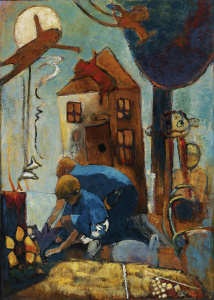
Martha R. Harding
(1933 - )
Becoming as a Little Child 1994
oil on canvas, 41.5” x 29.5”
Martha Rasmussen Harding was born in Provo, Utah. During the depression, her family moved to Salt Lake City, where her father started his own business as a meat cutter. Her mother was an artist (she had taken art in college) and hung a few paintings in the family home. However, as soon as Martha's mother had children, she quit painting. Martha had one brother and two sisters. As a child, she was always drawing and doodling. When she was six, she entered a patriotic poster contest and won. The prize was an ever-sharp pencil. Martha remembers taking art classes in the summer recreation program and making things out of clay and leather. These artistic experiences were a great joy to Martha, but she has wondered why her mother didn't encourage her to be an artist.
Martha Harding married soon after graduating from high school, and her interest in art had to be put on the back burner until her first child entered kindergarten. Then one day her son brought home a flier offering adult-education classes in art, and she and a neighbor decided to go to some of the art classes together. These classes heightened her interest in art as well as teaching her art skills. She started teaching oil painting classes in her home and did this for 16 years. During this period, Harding mostly painted landscapes.
Harding remembers that she organized her house with the specific purpose of allowing herself time to paint. One day she said to one daughter, "Chris, your name should be Chris Play Harding," to which her daughter promptly replied, "Your name should be Martha Paint Harding!"
In 1984, after all of her children were attending school, she decided to attend Brigham Young University. She wanted to gain more skills to share with her students. Soon, taking art classes wasn't enough, she wanted to get her Bachelor of Fine Arts. In 1990, Martha received her BFA, and in the spring of 1995, she earned a Master of Fine Arts in painting from Brigham Young University.
Martha Harding is the mother of 7 children and grandmother of 15, and she tries to express in her art that the time invested in the family pays off. She admires Minerva Teichert as an artist and as a mother. Harding feels that even though their paintings don't look anything alike, a strong parallel exists between their art. Teichert talked of her children as her jewels and expressed that her painting seemed to call to her --she felt her art and family were intertwined. Martha Harding talks of two goals in her painting: " The first, which is more important to me, is to reveal the fact that family can be a blessing in spite of the burden, and second, is to allow the viewer to re-experience the emotions felt toward the family from a child's point of view."
Recently, Harding received a letter from her daughter-in-law telling about an incident with Harding's granddaughter Kellie. Kellie had told her mother she was having a hard time trying to decide if she wanted to be an artist or a mommy. Her mother told Kellie that her grandmother was proof she could successfully do both. Kellie was thrilled, and said she wants to be an artist like her grandma because "I love to paint and draw like grandma, and also, we both like to eat."
Martha Harding's present direction in art grew out of several wonderful drawings sent to her by her grandchildren. One of these drawings was of a house, which inspired her to create paintings that display her own spontaneous drawings and the children's drawings together. She approaches the serious subject of families in a playful way. Harding describes her artistic process by explaining,
As I work on these canvases, I use collage, children's drawings, and my own intuitive drawings. I enjoy the integration of the unexpected, the abstract, and the concrete, which allows me to create a world of imagination. I am constantly surprised at how my intuitive drawings always seemed to fit in with the theme of the painting. They start with doodles while I am listening to music. I then expand the doodles with drawing and painting. It is evident that cadmium red light paint is my favorite color, and a painting does not seem to be complete without a dash of it here and there.
Martha Harding creates a new visual language free from the academic world of realism--a language filled with symbols from the heart. In February of 1994, her husband Ray woke her up to tell her a dream he had about her paintings. He suggested that the backs of children (often included in her paintings), are symbolic of a child's view, "we watch them observing their world."
These and many other symbols are present in Harding's paintings such as the following: double doors on a house are the double standards of the world, vertical lines are symbols of stability created by parents, floating figures are symbols of the child's imaginary world, bright colors are symbols of the happiness of families, the colored underpaintings allowed to show through in areas are symbols of the unexpected happenings in life and the family, and her imagery-filled canvases are due to her desire to please everyone--like a hostess at a family reunion trying to help everyone have a good time--she is the hostess of the canvas. A graduate student visited her studio and said, " I really like your work. When I look at it, it makes me happy." Martha says, " that is exactly what I want to portray!"
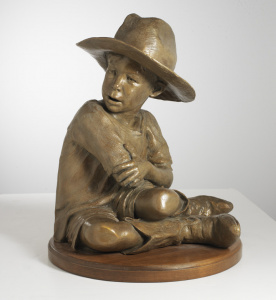
Dan L. Hill
(1929 - )
Cowboys Don’t Take Naps 1997
bronze, 19” x 16” x 15.5”
Dan Leroy Hill of Sandy, Utah, is a veteran of the Korean War. He first studied art at the Pioneer Craft House with sculptor Karl Quilter and received critiques from Avard Fairbanks and Edward Fraughton. He was a landscape maintenance worker so he had free time in the winter to work on his art, developing into a talented academic realist sculptor of bronze casts, usually of children, western and domestic genre themes. He participated with small sports pieces at the Loveland, Colorado, show and in the 1998 April Salon; the Springville Museum of Art bought his bronze Cowboys Don't Take Naps.
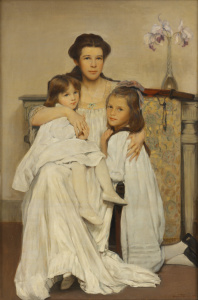
William Sergeant Kendall
(1869-1938) Spuyten Duyvil, NY
The Artist’s Wife and Daughters 1906
oil on canvas, 60” x 40”
William Sergeant Kendall studied and exhibited in Paris before venturing back to America to work and teach. His most common subject was that of mother and child, and many of his best paintings are of his own daughters. His highly popular The Artist's Wife and Daughters depicts Kendall's family at evening time. A feeling of peace, maternal tenderness and filial devotion emanates from the canvas and is enhanced by the embrace that binds them together. The white of their nightgowns seems clean and pure and imbues the work with a sense of angelic innocence, which is echoed in the peaceful serenity of the three faces. Interestingly, Margaret Kendall's left eye is hazel, like Beatrice on her lap, and her right eye is blue, like those of Elisabeth kneeling beside the chair.
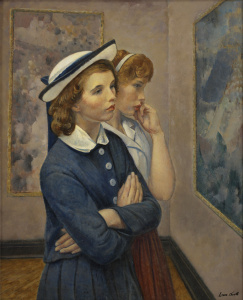
Leon Kroll
(1884-1974)
Girls at the Exhibition 1964
oil on board, 32” x 26”
From Rogallery.com: Leon Kroll was a painter, lithographer, art critic and teacher who was born in 1884 in New York City. Living his professional life in New York City and Chicago, he summer in Rockport, MA and became one of the most popular and famous of its painters by 1920.
Kroll studied at the Art Students League in New York City and with John H. Twachtman in 1901, the National Academy of Design in 1903 and the Academie Julian in Paris from 1908-1909 with Jean Paul Laurens. He was an Associate (1920) and full Academician (1927) of the National Academy of Design; a member of the
New Society of Artists; Philadelphia Art club; American Society of Painters and Sculptors (president, 1931-1935); Boston Art Club; National Institute of Arts and Letters (vice-president, 1943); American Academy of Arts and Letters (1950, director and chairman of the art committee); Woodstock Art Association; and the National Art Club (life member). His first solo exhibition was given in 1910 at the National Academy of Design and many followed.
Kroll's accomplishments in art are vast and he won prestigious awards at the Pennsylvania Academy of Fine Art (1927, 1930); Salmagundi Club (1912); Pan-Pacific Exposition (1915); Art Institute of Chicago (1919, 1924, where he showed his work in a two-man show with George Bellows); Wilmington SFA (1921); National Academy of Design (1921, 1922, 1932, 1935, 1943, 1965); the Carnegie
Institute (1926, 1936); Newport AA (1929, 1939); National Arts Club (1930); Boston Art Club (1932); International Exposition, Paris (1937); Philadelphia Art Alliance (1941); and the Chevalier, Legion of Honor, France (1950).
Kroll is represented in the permanent collections at the Corcoran Gallery of Art; PAFA; Metropolitan Museum of Art; Museum of Modern Art; Art Institute of Chicago; Carnegie Institute; Los Angeles County Museum of Art; Dayton Art Institute; Detroit Institute of Art; Denver Art Museum; San Diego Fine Art Society; Norton Gallery; St. Louis Museum of Art; John Herron Art Institute and hundreds more. He was commissioned to do murals for the U.S. Military Cemetery, Omaha Beach, France and the John Hopkins University Auditorium. He was a teacher at the National Academy, the Maryland Institute of Art, the PAFA and the Arts Student League and painted in Gloucester by 1912.
He became a close friend of Chagall and R. Delaunay in France and in 1917 he went to Santa Fe to join Robert Henri and George Bellows on painting excursions. By 1920, he was one of the most famous realists in America and in 1937 he was given a retrospective exhibition at the Worcester Museum in 1937. He died in Gloucester in 1974.
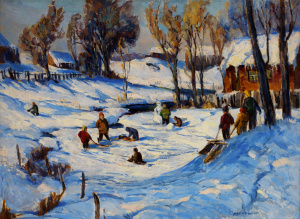
David Howell Rosenbaum
(1908-1983)
Children at Play in Mantua, Utah c. 1937
oil on board, 22” x 30”
The expressionist painter and Judeo-Mormon artist, Howell Rosenbaum, was one of Utah's great colorists. He began drawing and painting when he took a class in high school from Lura Redd. In his high school years, he purchased a Model T Ford. Often, Howell and his brother, Paul, traveled into the local canyons where Paul fished and Howell painted. Howell graduated from Box Elder High School in 1926.
Rosenbaum's father and grandfather owned a successful mercantile business in Brigham City. Howell's father was not supportive of his son's desire to become an artist. He told Howell to get a "real job" because he could never make a living painting. Following his father's advice, Howell worked as a newspaper boy, as a delivery boy and wrapper in a bakery, and as a section crewman for the Union Pacific Railroad. However, during these years he continued to paint.
Finally, in 1931, he enrolled at Utah State Agricultural College at Logan, where he studied with Calvin Fletcher. With Fletcher's help, Howell's natural talent began to flourish. He began painting canvases of vibrant color. During the Great Depression, the Works Projects Administration (WPA) paid artists according to the number of paintings they painted. It was during these years that Rosenbaum was at his creative prime, and many of his finest paintings were done during these Depression years.
Rosenbaum attended the American Artists School in New York City from 1938 to 1941. However, he considered his study in New York a waste of time because he did not feel the teachers helped him understand what he needed to know. Howell returned to Utah in 1941 and began teaching at the Utah Art Center. He also opened an art studio in Ogden, Utah.
Howell served in the U.S. Navy during World War II from 1942-1945. He was a mural and sign painter in the navy and produced about 200 watercolors and pastels during those years. He then returned to Utah in 1945 and again opened an art studio in Ogden, where he did portrait paintings.
Rosenbaum had an odd, whimsical, unconventional personality, and people often misunderstood him. He had low self-esteem and so was his own worst critic. He often pushed people away with an offending comment. Those who knew him best, however, saw a tender-hearted person. His paintings, which are warm and alive, show this side of his personality. His work is emotional, direct, bold, and colorful.
In Farmington Peak , the artist took an unprepared illustration board and covered it with linseed oil mixed with burnt umber pigment. The slippery oilsurface allowed Howell to paint out of doors (plein aire) in one sitting, until the picture was nearly finished. The method of beginning and finishing a painting in one sitting is called premier-coup or ala-prima. It is a difficult technique for any but the most accomplished and courageous of artists, but it can produce lively, spontaneous works.
In this painting, the artist used sharpened brush handles and actually drew into the wet paint. By scraping into the wet paint, the artist was able to add highlights and details that would have been otherwise very difficult to attain. This wet-into-wet painting technique creates a wonderful richness in color, texture, and light.
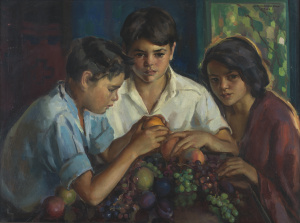
John Hubbard Rich
(1876-1954) Boston, MA
Mexican Children and Fruit 1932
oil on canvas, 30” x 40.25”
John Hubbard Rich was born in Boston, Massachusetts on March 5, 1876. He worked as an illustrator and for four years attended the Art Students League in New York. Following that he studied three years at the School of the Boston Museum, during which he was awarded a two-year travel scholarship to Europe. Upon his return he became a teacher at Groton School and in 1914 he and fellow artist William Cahill founded a school in Los Angeles, the School for Illustrating and Painting. He taught in Los Angeles at the University of Southern California and Otis Institute. He remained in Los Angeles until his death on March 30, 1954. John Rich is primarily known for his portraits, still lifes, figures and florals.
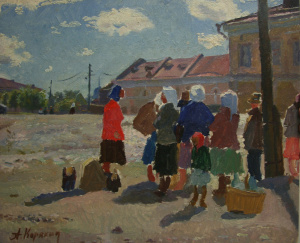
Yuri Dmitrievich Koryakin
(1929-1999) Boston, MA
Moscow Suburbs 1948
oil on board, 12.63” x 15.38”
Koryakin is known for his depictions of Russian life, particularly the lives of Russian workers. He began his academic study of art in 1946 when he entered the Kiev Art College. After exhibiting his work for a decade and becoming a well-known local artist, Koryakin was admitted as a member of the Ukranian Union of Artists.
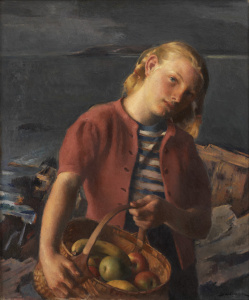
Robert Brackman
(1898-1980) Odes’ka Oblast, Ukraine
Girl From the Village 1958
oil on canvas, 30” x 25”
The girl in this portrait holds a basket of ripe fruit, but the background of sharp crags that drop into a dark sea offers no clues as to where the girl obtained this fruit. The artist deftly paints her blond hair, blue eyes, and casual clothes, capturing her relaxed but penetrating gaze. Born in Ukraine, Robert Brackman immigrated to the United States in 1908 to begin studying at the National Academy of Design. He grew in success and became a teacher at the Art Students League of New York. He was best known for his figural works and portraits of famous Americans, including Charles Lindbergh and members of the Rockefeller family.
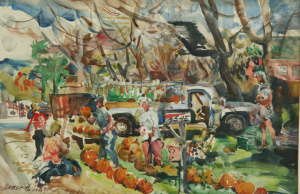
Homer Hone Clark
(1922-2010) Provo, UT
Halloween is Coming: Pumpkins on Parade 1986
watercolor, 9.25” x 13.38”
Homer Hone Clark was born in Provo. A Salt Lake City physician, he divided his time between the visual arts and other pursuits, finding time during and after study in Provo (to 1943)—at New York's Columbia University (1943), the Art Student's League (1943, 1948, 1950, 1957), and the University of Utah (1957)—to not only carry on his practice as a local pathologist associated with the LDS Hospital but also as a member in the Associated Utah Artists. He was also a doctor in the employ of the late Howard Hughes; made fine violins; had regular instate showings of his award-winning oils, very fluid and sophisticated watercolors, and graphics works; and published his drawings and paintings in several medical journals, including the Journal of the American Medical Association, and Pathologic Physiology.
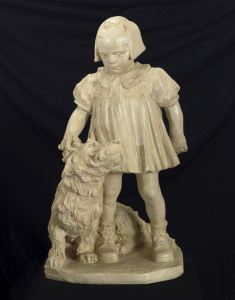
Avard Tennyson Faribanks
(1897-1987) Provo, UT
Polly with Rags 1934
plaster, 25” x 14” x 14”
Avard T. Fairbanks was born in 1897, in Provo, Utah. His initial instruction in art came from his father, John B. Fairbanks, who was an art teacher at Brigham Young Academy and also from his brother, J. Leo, who was a painter. Avard's first sculpture, a rabbit in clay, was done when he was 12. The sculpture won first prize at the 1909 Utah State Fair, but the judge refused to give Fairbanks the medal because he said the contest was for professionals, not for boys.
His family decided Avard should go to New York to study, where his father was making private sale copies of the masterpieces at the Metropolitan Museum. The curator at the museum gave reluctant permission for Avard to make copies because he was so young (13). After seeing the quality of Fairbanks' work, the curator apologized. After an article about him appeared in the New York Herald, he was allowed to model animals at the Bronx Zoological Gardens. A scholarship to study at the Arts Students League with James Earl Fraser soon followed. During this time, Fairbanks came to know several notable sculptors who gave him advice and critiqued his work.
He returned to Utah after a year and a half in New York because he wanted to study abroad. The sculpture Buffalo was made when he was 15. Although he had planned to pay for his travels by sales of Buffalo, funds came from sales resulting from attention garnered by a lion sculpture he made of butter for a creamery exhibit at the Utah State Fair. While in France in 1914, he became the youngest artist to be admitted to the French Salon: he was 17. However, his studies in Paris were cut short by the start of World War I, so he returned to Utah where he finished high school and continued modeling in clay.
His first major commission was with his brother, J. Leo, to work on the statuary and friezes of the LDS Hawaii Temple. In 1918, he attended the University of Utah. Then, at the end of World War I, he was commissioned to do a war memorial called Victorious American Doughboy for the state of Idaho. This commission led to other commissions and to a teaching position at the University of Oregon. Among his other commissions were the Ninety-first Division Monument, Pioneer Family, Pony Express , and four marble busts of Abraham Lincoln.
In 1925, he earned his Bachelor of Fine Arts from Yale and was awarded a Guggenheim Fellowship to study art in Rome and Florence the following year. His Mother and Child was sculpted during this period. He became a member of the faculty at the University of Michigan's Institute of Fine Arts in 1929 and while there, earned a Master of Fine Arts and also a Ph.D. in anatomical science.
Fairbanks always spent time researching his intended subjects to find background information that allowed him to include accurate details. For example, Fairbanks studied historical details of Lincoln's life as well as the president's life mask in order to portray him accurately. The anatomical studies he had done in college helped him make his figures very accurate.
In 1947, he returned to Salt Lake City with his family and was appointed Dean at the University of Utah where he was given the responsibility of organizing a college of Fine Arts. Considered an innovative and effective teacher, Fairbanks was, nevertheless, an "arch-conservative" artist. That conservatism resulted in departmental conflict as modernist teachers were hired but also resulted in a new generation of academically trained realist sculptors. Among Fairbanks' most successful students were Ed Fraughton, Justin Fairbanks (his son), Alice Morrey Bailey, Grant Speed, and Clark Bronson.
Retiring as Dean of the College of Fine Arts in 1955, Fairbanks taught for another ten years. He continued to produce sculpture and to criticize modern abstractionism until he died at age 90 in 1987.
Avard Fairbanks believed art should be simple and understandable, not only to the educated and technically trained, but also to children and the untutored. He believed art should be uplifting and represent the finer qualities of life to all men and women. He received numerous important commissions and honors throughout his career.
In addition to his religious sculptures, small and large bronzes, marble carvings, medals, and relief panels, Fairbanks created hood ornaments for Chrysler Motor Co. He had been asked to design a hood ornament for the Plymouth, and had designed a mermaid, which was approved. After approval of his mermaid design, Fairbanks was asked to design an ornament for the Dodge car. The design he came up with was a ram. When management from Chrysler came to see the design, they asked Fairbanks what a ram had to do with Dodge. Fairbanks replied that when people see a ram coming down the road they'll say "dodge!" He got the commission.
Fairbanks also has a serious and deeply religious side, and his sculpture Mother and Child exemplifies his belief in art as a portrayal of life's finer qualities. He lost his mother when he was fourteen-months old, and her loss consequently inspired him with great respect and honor for motherhood. Fairbanks said, "the arts are created for contemplation and edification, the expression of the highest ambitions and the spiritual hope of a people" and he applied this theory to his own art.
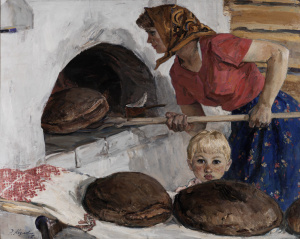
Engels Vasilevich Kozlov
(1926-2007)
Russian Mother Baking Bread 1967
oil on canvas, 55.5”
The artist was born in the village of Troitsko-Pechersk in the Komi Autonomous Republic. He first studied at Syktyvkar, the childrens' art school, in Komi, then in the Yaroslavl Art College from 1947-1949. Kozlov went to St. Petersburg (then called Leningrad) to study at Tavicheskaya Art School from 1949-1950 and then on to attend the prestigious Repin Institute from 1950 to 1956. He began exhibiting in 1956 and participated as a member of the All-Russian Congresses of Soviet Artists. For many years, he was the head of the Leningrad Art Union. He specialized in genre painting, paintings of everyday contemporary Russian life. He was particularly fascinated by life in the far north. He was known for his use of contrasting placement of blue-greens and golden browns. His style was a cross between Working-Class Impressionism and the Severe Style.
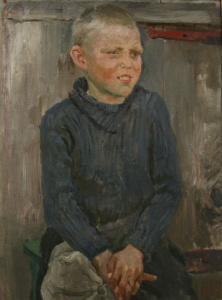
Arkadi Alexsandrovich Plastov
(1893-1972)
The Boy, Arkadi Kondratev, Prislonikha 1942-1946
oil on canvas, 25.38” x 19.38”
Arkadi Aleksandrovich Plastov was born in 1893 in the tiny village of Prislonikha to a family of peasants. His grandfather had been an icon painter. After 3 years at the local school, he entered the Simbirsk Spiritual Academy in 1903 and continued on into the Simbirsk Spiritual Seminary. But in 1912, he decided to study art and left for Moscow. He studied for a while in the studio of I. I. Mashkov and then entered the Stroganov Moscow State University of Arts and Industry. After that, he continued his studies in the sculpture department of the Moscow School of Painting, Sculpture, and Architecture. In 1917, he returned to his native village where he continued painting and working from nature until his death there in 1972.
Plastov is called “the singer of Soviet peasantry” for his genre paintings of daily life in Soviet villages and collective farms. His earlier works have strong political undertones glorifying the work of collectivization but also bespeak the artist’s personal devotion to his own village and of his country in general. With the outbreak of World War II, the artist turned began to show the suffering of villagers, particularly women and the elderly who struggled on the collective farms without the help of the men who left to the front. The painting, “Spring”, is a turning point in Plastov’s work. It depicts a nude mother undressing her daughter to go to the banya, the Russian version of a sauna. Completed in 1954, a year after Stalin’s death, this picture is completely devoid of political messages and demonstrates the beginning of the Khruschev Thaw, a political movement which allowed artists more political freedom.
